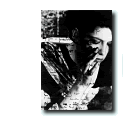|
 |
||
|
A Trilogy of Films by Sandra Lahire. Interview and review by Gill Addison |
Sandra Lahire has recently completed Living on Air, a trilogy of films inspired by the writing and voice of Sylvia Plath. The festival Handbags and Hardware opens with the world premiere of Johnny Panic, the final chapter of Living on Air, and offers the first chance to see this compelling and beautiful trilogy in its entirety.
A project spanning 9 years, Living on Air profiles, responds and concludes within three skillful intelligent films the work and life of Plath, who is portrayed as a writer, woman and independent soul free from the constraints that the literary establishment wishes to impose upon our memory of her.
In 1991 Lahire made Lady Lazarus, which sets out and introduces Plath's life and poetry. Lady Lazarus also begins to outline Lahire's creative concerns with film itself and the project which later evolved into this trilogy. Her interest in Plath began in response to both a personal bereavement and an image of someone's silhouette standing by the window of the house in which Plath had died. This haunting image stayed with Lahire and was later to reappear as a reoccurring image within Lady Lazarus. This image is more than a motif, and for Lahire it acts as a link to Plath, and as her touch stone within the film. "I had always been interested in the double edge between life and death" says Lahire, and Plath "is a the only poet that I think has travelled in a personal landscape of death, while at the same time writing in a language that is completely of life: trees growing rings, horses galloping."
The film combines images of Plath's home in Massachusetts, and themes from her poetry. Images and themes reoccurring in the later films creating an index of symbols, signs and metaphors. The postcard images of places of importance to Plath: her grandparent house, her college and her own portraits are hauntingly combined with Plath's own voice from both interviews and readings of her poems. Throughout Lady Lazarus, visual images of the text from Plath's poems and journals punctuate the screen images. These create a layered film, both physically and metaphophorically, with Plath's voice leading and navigating through the complex imagery. Lahire wanted to experiment within film "to see if people could just sit together in a cinema and close their eyes, and go on a journey". It was particularly important to Lahire that she use Plath's distinctive voice as a means of evoking her presence through the film, but also because her readings infuse her poetry with a powerful and vivid resonance which pierces through the visual experience of the film. "I wanted the audience to be able to close their eyes and listen to the film."
Night Dances was made in response to the need to work within a less controlled funding environment. Of the three films Lahire feels that this is her film. Two female couples glide and dance throughout the film, which is set in London. The women's journeys take them from the Thames and through cemeteries, accompanied by a haunting piano music. Night Dances' imagery is abstracted and less grounded as a translation of Plath's poems and her life. Again Plath's voice is used, but edited skilfully... words are repeated and isolated, ending in abrupt silences. Night Dances is more of a response to Plath than Lady Lazarus, and it is an intensely personal film for Lahire, whose mother helped make the film, but who died while it was still in production.
The final film of the trilogy is Johnny Panic. Within this film Lahire deftly combines the fictional aspects of Plath's writing with the stark reality of her life. Johnny Panic is a filmic and poetic text that evokes and adds to Plath's own dreams in the story 'Johnny Panic and the Bible of Dreams', and which grounds Plath's own recorded statement: "one should be able to control and manipulate experiences, even the most terrifying - like madness and being tortured..." ...
Thanks to Sandra Lahire.
Full article published in Filmwaves - Issue 10, Winter 2000. Subscribe now!
